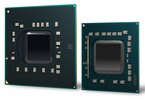Intel Graphics Media Accelerator (GMA) 4700MHD vs Intel Graphics Media Accelerator (GMA) 950
Intel Graphics Media Accelerator (GMA) 4700MHD
► remove from comparison
The Intel Graphics Media Accelerator 4700MHD (sometimes also called GMA X4700 HD or other combinations) is a DirectX 10 capable onboard graphics adapter in the GM47 chipset of the Centrino 2 platform (Montevina). The chip has no dedicated graphics memory, but takes dynamically an amount from the main memory (up to 384 MB).
Compared to the GMA 4500MHD, the 4700MHD features a higher core clock (plus 107 MHz) and is therefore a bit faster. Compared to the predecessor GMA X3100, the GMA 4500MHD has two more shaders and a 33 MHz higher core clock speed. Therefore, the chip is noticable faster than the older one (especially in 3DMark06). Still, the performance is just on par with the entry level dedicated graphics cards and therefore not suited for demanding games.
A new feature of the GMA chip, are the integrated HD video-decoding functions. The GM45 is able to decode HD-videos in the formats AVC, VC-2, and MPEG-2 to help the CPU. This way a Blu-Ray playback should also be possible with a low end CPU.
Intel Graphics Media Accelerator (GMA) 950
► remove from comparison
The Intel Graphics Media Accelerator 950 (also known as Intel GMA 950) is an integrated (onboard) graphic chip on the Mobile Intel 945Gx chipset for Intel processors. It is a faster clocked version of the GMA 900 and does not support hardware T&L (Transform & Lightning) calculations (which is required for some games). Compared to the GMA 900 it now supports Shader Model 3.0 (instead of 2.0) and can decode 2 HD Streams simultaneously.
It supports DirectX 9.0 with Shader Model 3.0 (Vertex Shader are calculated in Software - by the CPU) and OpenGL 1.4. Furthermore, the chip is able to accelerate the decoding of MPEG2 videos and supports Motion Compensation (2 HD Streams simultaneously). Modern HD videos in MPEG 4 or VC-1 can not be decoded with the graphics card.
The GMA 950 is integrated in the following chipsets with different rendering clock rates (that affect the 3D performance):
- 945GU: 133 MHz (Lakeport for Intel A100 and A110)
- 945GSE: 166 MHz (for Atom)
- 945GMS: 166 MHz / 250 MHz (1.05V)
- 940GML 166 MHz / 200 MHz (1.05V) - Celeron M (ULV)
- 943GML: 200 MHz
- 945GM: 250 MHz (Calistoga)
- 945G, 945GC, 945GZ: 400 MHz (Lakeport)
Using the GMABooster tool, slower variants can be clocked to 400 MHz to increase the 3D performance (use at your own risk, not supported by Intel!).
The GMA 950 can not be described as a graphics card that is sufficient for gamers. Still Intel published a list of games that will run (not needingly beautiful) on the notebook (list is for the GMA 900). Some old 3D games and especially 2D games should run without problems. The advantage of integrated graphics cards, is that they have a low power consumtion and therefore save battery life. Furthermore, the laptop may stay cooler and more silent than laptops with dedicated graphics cards. For office programs and surfing the performance is more than sufficient.
The newest drivers support Windows Vista with Aero Glass effects and according to some of our readers it should run fluently.
| Intel Graphics Media Accelerator (GMA) 4700MHD | Intel Graphics Media Accelerator (GMA) 950 | |||||||||||||||||||||||||||||||||||||||||||||||||
| GMA Series |
|
| ||||||||||||||||||||||||||||||||||||||||||||||||
| Codename | Montevina | GMA 950 | ||||||||||||||||||||||||||||||||||||||||||||||||
| Architecture | Gen. 4.5 | Gen. 3 | ||||||||||||||||||||||||||||||||||||||||||||||||
| Pipelines | 10 - unified | 4 / 0 Pixel- / Vertexshader | ||||||||||||||||||||||||||||||||||||||||||||||||
| Core Speed | 640 MHz | 250 MHz | ||||||||||||||||||||||||||||||||||||||||||||||||
| Shared Memory | yes | no | ||||||||||||||||||||||||||||||||||||||||||||||||
| API | DirectX 10, Shader 4.0 | DirectX 9c, Shader 2.0 | ||||||||||||||||||||||||||||||||||||||||||||||||
| technology | 65 nm | 130 nm | ||||||||||||||||||||||||||||||||||||||||||||||||
| Features | Enhanced Intel Clear Video Technology, HD Video Decoder (VC/VC2/MPEG2), HDMI mit HDCP Support, Display Refresh Rate Switching Technology, Render Standby | No Hardware Transform & Lightning (T&L), Hardware Motion Compensation, Hardware MPEG2 acceleration | ||||||||||||||||||||||||||||||||||||||||||||||||
| Date of Announcement | 01.10.2008 | 01.03.2005 | ||||||||||||||||||||||||||||||||||||||||||||||||
| Link to Manufacturer Page | www.intel.com | www.intel.com | ||||||||||||||||||||||||||||||||||||||||||||||||
| Power Consumption | 7 Watt | |||||||||||||||||||||||||||||||||||||||||||||||||
| Information | Windows Vista Premium Ready |
Benchmarks
Average Benchmarks Intel Graphics Media Accelerator (GMA) 950 → 0% n=0
* Smaller numbers mean a higher performance
1 This benchmark is not used for the average calculation
Game Benchmarks
The following benchmarks stem from our benchmarks of review laptops. The performance depends on the used graphics memory, clock rate, processor, system settings, drivers, and operating systems. So the results don't have to be representative for all laptops with this GPU. For detailed information on the benchmark results, click on the fps number.
| Intel Graphics Media Accelerator (GMA) 4700MHD | Intel Graphics Media Accelerator (GMA) 950 | |||||||||||||
|---|---|---|---|---|---|---|---|---|---|---|---|---|---|---|
| low | med. | high | ultra | QHD | 4K | low | med. | high | ultra | QHD | 4K | |||
| Left 4 Dead | 2 | |||||||||||||
| Half Life 2 - Lost Coast Benchmark | 2 | |||||||||||||
| F.E.A.R. | 38 | 3 | 1 | |||||||||||
| World of Warcraft | 15 | |||||||||||||
| Doom 3 | 4 | |||||||||||||
| Quake 3 Arena - Timedemo | 88 | |||||||||||||
| Intel Graphics Media Accelerator (GMA) 4700MHD | Intel Graphics Media Accelerator (GMA) 950 | |||||||||||||
| low | med. | high | ultra | QHD | 4K | low | med. | high | ultra | QHD | 4K | < 30 fps < 60 fps < 120 fps ≥ 120 fps | | | | | | | < 30 fps < 60 fps < 120 fps ≥ 120 fps | 3 1 | 1 | 2 1 | | | |
For more games that might be playable and a list of all games and graphics cards visit our Gaming List

















